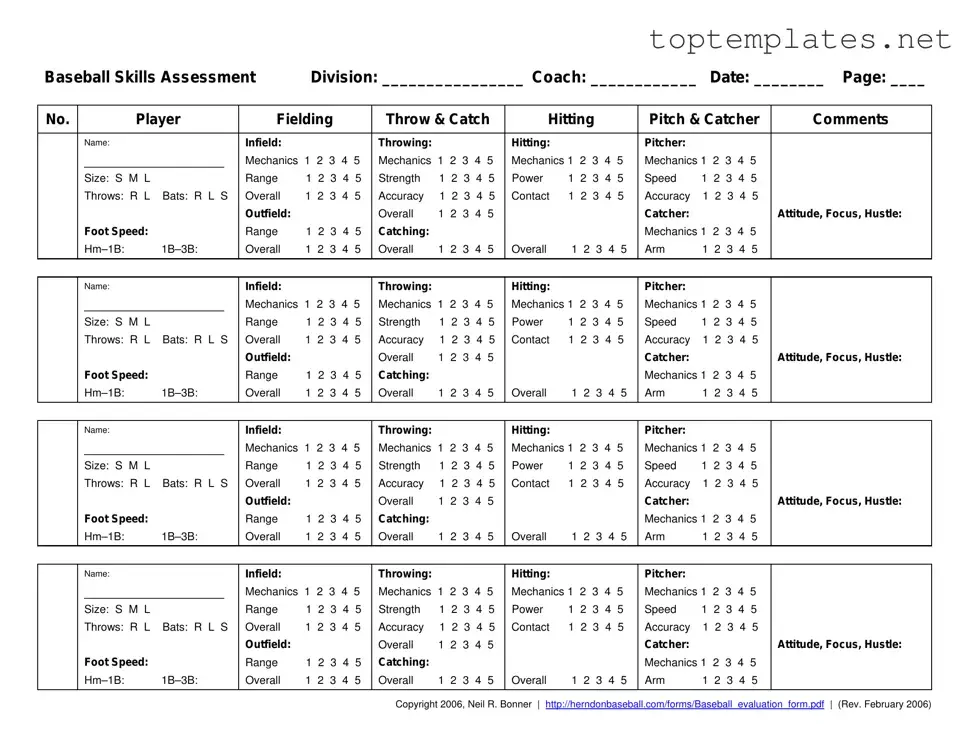What is the purpose of the Baseball Skills Assessment Form?
The Baseball Skills Assessment Form is designed to evaluate the skills of players systematically during tryouts. Its objective is to objectively quantify each player's abilities across various aspects of baseball, such as fielding, throwing, catching, hitting, and pitching. The form helps coaches and evaluators select players for teams, particularly for All-Star travel teams or drafting within "house" leagues. It ensures a fair and balanced team selection process by providing a standardized way to measure players' skills.
How should coaches score players using the form?
Coaches should score players on a scale from one to five points in each listed skill category. A score of five indicates an exceptional level of ability, while a score of one suggests an extremely poor level of ability. Scores of two, three, or four are given for levels of skill in between these two extremes. This scoring system allows for a detailed assessment of a player’s strengths and weaknesses.
How are the first eight players on the team selected?
The first eight players on a team are selected based on their quantitative scores from the Baseball Skills Assessment Form. This method ensures an objective approach in choosing players who demonstrate a higher level of skill across various aspects of the game. It provides a fair chance for all participating players by basing the selection on measurable performance rather than subjective opinions.
Can managers add points for pitching or catching skills?
Yes, managers have the discretion to add between one and five points for pitching or catching skills. Pitching and catching are critical positions on a baseball team, and special consideration is given to players who excel in these areas. This allows managers to recognize and reward the unique skills and the strategic importance those positions hold on a team's overall performance.
Is there a specific format for conducting tryouts?
Yes, the league should follow a structured format for tryouts, designed to take between 2 and 2.5 hours. This format includes an introduction, warm-up, skill assessments in base running, infield and outfield skills, hitting, and evaluations for pitchers and catchers. Structuring tryouts in this manner ensures each player has the opportunity to be evaluated fairly across all necessary skills.
How are evaluations conducted for base running?
Base running evaluations involve timing players as they run from the batter's box to first base and then from first base to third base. Players are encouraged to overrun third base to avoid sliding. Accuracy in tagging each base is monitored, and times are recorded to assess each player's foot speed and efficiency in base running.
What does the assessment include for infield and outfield skills?
The assessment for infield skills involves having players rotate through infield positions while the coach hits balls to evaluate their fielding range, throwing accuracy, and ability to make plays, such as double plays. Outfield skills are assessed by positioning players in the outfield, simulating fly balls to evaluate their catching range and movement, followed by throwing to bases. This setup tests a player's defensive capabilities in real-game scenarios.
How is hitting evaluated during the tryouts?
Hitting is evaluated by providing each player with 5 to 8 good pitches, using a pitching machine for consistency, if available. Players may be assessed on their mechanics, power, and contact with the ball. Bunting the first pitch is optional but can be part of the evaluation to assess a player's versatility and skill in hitting.
What are the additional considerations for player selection?
While the primary basis for player selection is their performance scores on the Baseball Skills Assessment Form, coaches may award or deduct points based on demonstrated attitude, focus, and hustle. These qualities are important for team dynamics and success, allowing coaches to consider not just skill but also player behavior and contribution to the team environment.
When will players know if they have been selected for the team?
At the conclusion of the tryouts, players will be informed about when a decision will be made regarding team selection. This communication ensures transparency in the selection process and allows players and their families to manage expectations regarding participation in the team.

